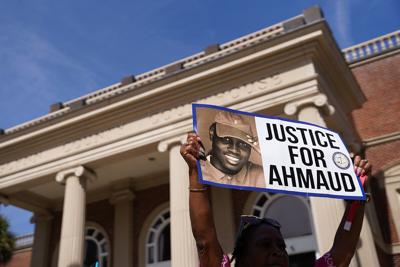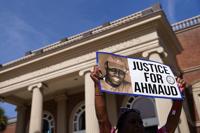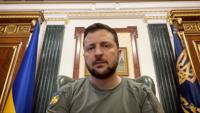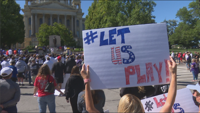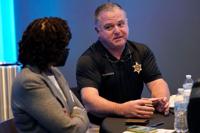Prosecutors in the trial of charged with the killing of Black jogger argued in opening statements Friday the defendants tracked down the 25-year-old, cornered and fatally shot him without evidence or knowledge Arbery had done anything wrong, despite saying they were attempting a citizen's arrest.
"We are here because of assumptions and driveway decisions," prosecutor Linda Dunikoski told the jury in her opening statement.
"In this case, all three of these defendants did everything they did based on assumptions," she said. "Not on facts, not on evidence -- on assumptions. And they made decisions in their driveways based on those assumptions that took a young man's life. And that is why we are here."
Jurors -- 11 White and one Black -- selected in were sworn in Friday morning, tasked with deciding whether Gregory McMichael, his son Travis McMichael and their neighbor, William "Roddie" Bryan Jr., are guilty of malice and felony murder in connection with Arbery's shooting. They also face charges of aggravated assault, false imprisonment and criminal attempt to commit false imprisonment. not guilty.
Arbery, 25, was out for a jog on February 23, 2020, near Brunswick when he was shot and killed. surfaced more than two months later, sparking just weeks before the set off a summer of nationwide protests against racial injustice.
The McMichaels said they were conducting a citizen's arrest on Arbery, whom they suspected of burglary, and that Travis McMichael shot him with a shotgun in self-defense. Bryan, who recorded a video of the shooting, allegedly hit Arbery with his truck after he joined the McMichaels in chasing Arbery. The three men were allowed to leave the scene and weren't arrested until after the video of the shooting became public.
Defense attorneys were presenting their own opening statements Friday afternoon.
Arbery's father left the courtroom before footage of the shooting was played in court Friday, according to a pool reporter present. As the footage played, an audible sob or gasp was heard from Arbery's mother.
Outside, Arbery's mother told reporters it was the first time she'd seen the video of the shooting in its entirety.
"I avoided the video for the last 18 months," Wanda Cooper-Jones said. "I thought it was time to get familiar with what happened to Ahmaud in the last minutes of his life. So I'm glad I was able to stay strong and stay in there."
Prosecutors detail shooting and events leading up to it
Dunikoski laid out for the jury the months leading up to the shooting, when the owner of a home under construction in the Satilla Shores neighborhood grew concerned about people wandering onto the "open" and "unsecured" construction site.
Prosecutors showed the jury videos of Arbery entering the site, each time wandering around and leaving without incident, noting that other individuals had also been present on the property. The homeowner had contacted police about the issue several times, Dunikoski said, but told them Arbery -- who was unidentified at the time -- had never taken anything.
The day of the shooting, Arbery entered the construction site again and was seen by a neighbor who called authorities on a nonemergency line, Dunikoski said. Arbery left the site and ran further into the neighborhood, at which point he was seen by Greg McMichael, who was in his driveway.
"This is driveway decision number one," Dunikoski said. McMichael went into his house, got his son Travis and both armed themselves -- the younger McMichael with a Remington 12 gauge shotgun. They got in Travis McMichael's truck and pursued Arbery -- the next "driveway decision," the prosecutor said.
At this time, Dunikoski said, neither had any knowledge Arbery had done something wrong, nor that he had been on the construction site.
Soon after, Bryan, who was on his porch, saw an exchange between the McMichaels and Arbery, during which Dunikoski said Travis McMichael asked Arbery where he was coming from and what he was doing. Per video shown in court, Arbery ran off and was followed by the McMichaels.
Bryan got in his own truck and joined the pursuit -- his own "driveway decision" -- though he also did not know what was going on, Dunikoski said.
Dunikoski characterized the next few minutes as an attack on Arbery, who turned away from the McMichaels, back down the road toward Bryan. Bryan tried to hit Arbery, who got so close to the truck that he left a palm print and T-shirt fibers on the truck, Duniksoki said. Bryan redirected Arbery up the road, back toward the McMichaels.
At one point during the pursuit, Dunikoski said Gregory McMichael told Arbery, "Stop or I will blow your f**king head off.
Prosecutors played footage that included the widely seen video taken by Bryan depicting the fatal shooting, which occurred as Travis McMichael and Arbery wrestled over the shotgun. Arbery's father left the courtroom before it started, according to a pool reporter in the courtroom, and his mother sobbed as the video played.
The "truly, truly tragic" part of the shooting, was that an officer dispatched in response to the initial call by the neighbor was in the neighborhood and heard the gunshots, Dunikoski said.
Despite their defense, Dunikoski said that at no point during subsequent interviews with police did the defendants state they had seen Arbery commit a crime or that they were trying to conduct a citizen's arrest.
"The defendants assumed the worst about Mr. Arbery and made their driveway decisions," Dunikoski said.
Following the state's opening, the judge declined to grant a mistrial after defense attorneys complained prosecutors inappropriately raised the issue of the time-lapse between Arbery's shooting and the arrest of the defendants in her opening statement (Walmsley had previously ruled any mention of this period should not be made in front of the jury).
Travis McMichael had 'duty and responsibility', attorney says
In his own opening statement, Bob Rubin, an attorney for Travis McMichael, described the case as one about his client's "duty and responsibility" to his family and neighborhood. He also highlighted law enforcement training Travis McMichael received during his time in the US Coast Guard that Rubin said had been drilled into him to the point it became muscle memory.
Rubin also detailed the months before the shooting, as the owner of the home under construction, Larry English, grew concerned about people on his property and items he believed had been stolen from his boat stored at the site. He shared that information with neighbors, Rubin said, along with the video clips of people on the property.
On February 11, 2020, Rubin said Travis McMichael had a run-in with Arbery who had entered English's house again. Travis McMichael called 911 about the incident, during which he said the person he encountered had reached into his pocket, according to audio of the call defense attorneys played in court. Rubin said this gave Travis McMichael the belief Arbery could be armed.
Twelve days later, the fatal shooting occurred. When Gregory McMichael saw Arbery and walked inside to get his son, he told him, "it's the guy," referring to the person seen on English's property.
"They're not guessing," Rubin said. "It's not some random guy running down the street. It's the guy, and they turn out to be right."
The father and son were trying to conduct a citizen's arrest, Rubin said. And while he acknowledged defense attorneys were not contending Arbery committed a crime in the defendants' presence, Travis McMichael had probable cause to detain Arbery, Rubin said.
Travis McMichael grabbed a shotgun, he said, because he feared Arbery could be armed based on their run-in on February 11. Travis McMichael did not initially show his weapon, Rubin said. But he became fearful when he saw the encounter Arbery and Bryan (who Travis McMichael did not know), believing Arbery was trying to steal Bryan's truck, Rubin said.
Eventually, Travis McMichael asked his father when the police was coming. When Gregory McMichael said he'd not called the police, Travis McMichael took out his phone, dialed 911 and handed the phone to his father.
"Before the first shot is fired, they call the police," Rubin said. "That is not evidence of an intent to murder."
Travis McMichael only showed his weapon to try and de-escalate the situation according to the training he'd received in the Coast Guard, Rubin said. Arbery then ran at Travis McMichael, who pointed the weapon at Arbery, though Rubin said he did not want to kill him. When he did fire, Rubin said Travis McMichael had no choice.
"The evidence shows overwhelmingly that Travis McMichael honestly and lawfully attempted to detain Ahmaud Arbery according to the law and shot and killed him in self-defense," Rubin said.
The day Arbery was killed
Arbery was on a jog in the neighborhood of Satilla Shores, outside the city of Brunswick, when the McMichaels grabbed their guns and pursued him. Gregory McMichael told police they pursued Arbery because they suspected he was responsible for a string of nearby purported burglaries. A local police spokesperson later said there had only been one burglary reported in more than seven weeks before the shooting.
Gregory McMichael, a former police officer and investigator in the local District Attorney's office, told police Arbery and his son struggled over his son's shotgun before Travis McMichael shot Arbery after the latter attacked him, according to a police report. Bryan joined the pursuit and recorded the shooting on his phone.
Following the deadly shooting, the case lay dormant for more than two months, and two prosecutors recused themselves due to conflicts of interest. But video footage of Arbery's killing surfaced on May 5, 2020, prompting protests and calls for the arrests of the men involved.
Attorneys for the McMichaels said Travis acted in self-defense. But the opposite was true, Georgia Bureau of Investigation Assistant Special Agent in Charge Richard Dial testified during a preliminary hearing last June.
"I believe Mr. Arbery was being pursued, and he ran till he couldn't run anymore, and it was turn his back to a man with a shotgun or fight with his bare hands against the man with the shotgun. He chose to fight," Dial said.
"I believe Mr. Arbery's decision was to just try to get away, and when he felt like he could not escape, he chose to fight," he added.
The-CNN-Wire
� & © 2021 Cable News Network, Inc., a WarnerMedia Company. All rights reserved.

